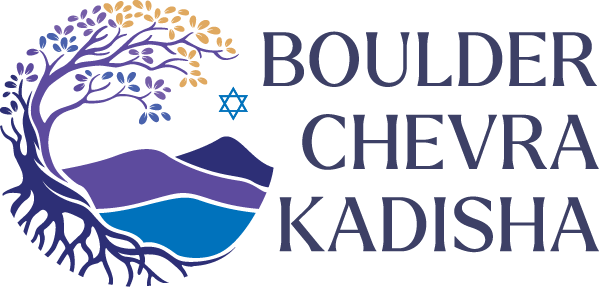Ritual Services
Between the time of death and the actual burial, there are two Jewish rituals, shmirah and tahara, which serve to honor the deceased and prepare the body for burial. They are two of the primary rituals performed by the community members who make up the Boulder Chevra Kadisha.
Tachrichim
In Jewish tradition, the met/meta is not dressed in ordinary attire, whether everyday or formal wear, as in other traditions. After the ritual washing of tahara, members of the chevra kadisha dress the met/meta in ritual garments, the tachrichim. The tachrichim are reminiscent of the simple white linen garments worn by the high priest.
The tachrichim, made of natural biodegradable fibers,consist of five garments, a head covering (mitznefet), pants (michnasayim), shirt (k’tonet), tunic (kittel), and belt (avnet or gartel).
Aron
The met/meta may be buried in a wooden casket, in Hebrew, the aron, or ark. Because Jewish tradition encourages a speedy return of the body to the earth, metal caskets are not used, nor is metal used as hardware on traditional wooden caskets. Wooden caskets have holes in the bottom, so that the body is closer to the earth.
The caskets are unadorned, but often identified as a Jewish casket by a wooden Magen David, a Star of David, on top. A wrapping sheet, or sovev, is placed in the casket, to be wrapped around the dressed met/meta.
In some cemeteries, caskets are optional, and families can choose to bury their loved ones directly in the earth, using only a lowering board under the body and a protective shroud over it.
Shmirah
Shmirah is the ritual of guarding the deceased’s body. Some call it “accompaniment,” as we are ensuring that the soul does not feel alone during this time in which it is adjusting to not having a body.
A shomer watches over the deceased from the time the deceased comes under the responsibility of the Chevrah Kadisha until the funeral and burial. In earlier times, the guarding of Jewish bodies was a physical concern, while today it provides comfort to the soul of the deceased and to the grieving families. Shmirah is generally done in shifts, with each person doing the task for one to two hours.
Tahara
Tahara, the ritual of preparing the dead for burial is a carefully choreographed ritual performed by volunteers of the Boulder Chevra Kadisha. The ritual includes physical washing of the body along with pouring of pitchers of water, reading liturgy and dressing the body (met/meta), while honoring the dignity and sacredness of human life. This is all intended to assist the soul on its journey.
In Jewish tradition, we are all holy beings created in the image of the Divine. This means that when we die, our body is considered a holy thing and should be treated with respect and dignity. Jewish tradition also considers the holy spiritual aspect of a human being, the soul, to be eternal, returning to the Divine upon death.





